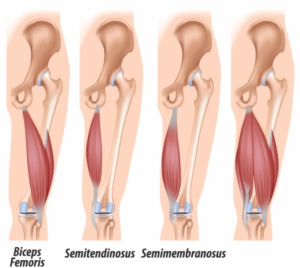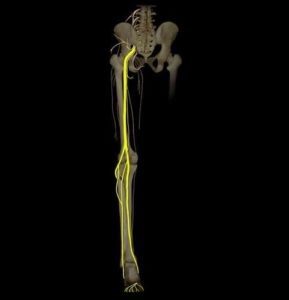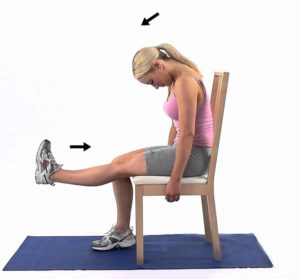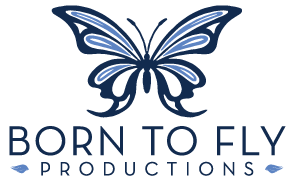It is an all too common occurrence. A new – or seasoned – aerialist finds themselves stuck in their flexibility journey. It seems that no matter how often and hard they stretch, no matter how many different approaches they take, their flexibility simply will not improve. Maybe it’s just the way our bones are shaped? Or maybe even our muscles are just too large? The list of possibilities goes on and on… But something that maybe you haven’t heard of yet is that your nerves might be highly involved. What does this have to do flexibility and how can we fix it? In this post, Jenn Crane of Cirque Physio discusses how to improve your nerve flexibility specifically in the hamstrings. Hamstring mobility directly impacts many of the popular flexi-positions we find ourselves in during aerial dance, such as splits and the pike.
-
Anatomy of the Posterior Thigh (The Back of Your Leg)
There is a lot going on in your posterior thigh. For the sake of simplicity, I’m going to discuss the anatomy of the two main structures that most frequently limit flexibility in your pike stretch: hamstrings and your sciatic nerve.
Hamstrings
There are three hamstring muscles (per leg) and they all originate on the bottom of your pelvis (half of one originates on the back of your thigh bone, if we’re being picky). They course down the back of your thigh, and insert on the bones of your lower leg- the top of your tibia and fibula, just below the back of your knee.

What Makes Hamstrings Stretch?
To fully stretch any muscle, you have to move the insertion away from the origin. For hamstrings specifically, this often looks like the standard forward fold/pike stretch. However, frequently in this stretch, we let our pelvis rotate downward (“tail tucked” position), which technically means you’re not fully stretching the hamstrings, because the origin is creeping towards the insertion. To get a true hamstring stretch, the knee must be extended straight, and the pelvis must not be posteriorly tilted.
Sciatic Nerve
The next potentially pike-limiting structure of the posterior thigh is the sciatic nerve and its branches. This is the largest nerve in your body, and is about the diameter of your pinky finger. The sciatic nerve is formed from several segments of nerves exiting your spinal cord in your lower back, then it courses down behind the gluteal muscles, in between your hamstrings, and all the way under your calves and into the bottom of your feet (it branches into other nerves at several points along this course, but they’re all connected).

What Stretches the Sciatic Nerve?
Because this nerve runs from your low back to the bottom of your feet, to completely stretch this nerve, we can also be in a pike stretch- but there are several key differences with this vs the aforementioned hamstring stretch! Here’s what puts the sciatic nerve on max tension: Sitting in a pike, slouching forward (spinal flexion/tail tucked), and feet flexed.

-
Nerve Flossing
Okay, so…how do you un-stick the nerve? Nerves tend to respond very well to a “gliding/flossing” action as opposed to a long hold “tensioning” action. This means that you increase tension at one end of the nerve, and put the other end of the nerve on slack- then reverse this motion. Nerves respond better to slow rhythmic movement, and as such, you want to repeat this “gliding” pattern for multiple repetitions in one set.
This video discusses proper nerve gliding technique.
-
Nerve Mobility Exercises
For the purpose of your pike, I like to use the following sequence of events in this order:
Tissue Prep
Sit on a hard surface (chair, panel mat, weightlifting bench) with a lacrosse ball or peanut right below where your glutes meet your hamstring, and knee bent. Start by straightening and bending your leg, and apply light pressure to the top of your thigh if you want to ramp up the intensity. Do this at three different points along your hamstring. You can also do this along your calf with your legs stretched in front of you.
Video demonstration: https://youtu.be/mgvr_NLUtvU
Nerve Flossing/Gliding
There are a lot of ways to do these, but the variation that seems to be the one that works quite well for most performing artists starts with lying on your back. First, grab behind the back of your knee and pull towards your opposite shoulder. Keep your toes pointed and straighten your leg as much as you can before you feel a slight tug – you could feel it in a few different places- hamstring, behind the knee, calf, or foot. Once you start to feel the tug, back off the stretch- bend your knee and flex your foot until you’re back in the starting position. Repeat this 10-15 times per side. **It is not beneficial to push into a big stretch or go to the point of pain, improving nerve mobility is not a “no pain no gain” type thing. Do not worry if your leg doesn’t straighten completely.
Video Demonstration: https://youtu.be/1zD1pTNbrhg
Active Flexibility: Bend and Snap
This is a great exercise for active hamstring flexibility. Start standing on one leg, with the other foot propped beside the standing ankle (for balance). During this whole exercise, you must keep your back straight and standing leg knee not locked out- with a very slight bend. Slowly reach forward, back straight, as far as you can go before your back bends or your hamstrings tell you to stop. Think about “booty out” the whole time. This keeps your pelvis anteriorly tilted, and ensures maximal hamstring stretch. If this is too easy, try the same thing but balancing on one leg instead of using the other leg for support. Keep your non-weight bearing foot glued to opposite ankle, don’t let it drift back.
VIdeo Demonstration: https://youtu.be/ByfhMjI0PJo
A big thanks to Jenn Crane for providing all of the material for this blog post! Dr. Jennifer Crane is a physical therapist, athletic trainer, board certified orthopedic specialist, and published author. She has been a sports medicine professional for eleven years, and has worked with a wide variety of athletes and performing artists throughout that time. In 2015, she worked as a physiotherapist living in China with the Chinese Olympic Teams in preparation for the Rio 2016 Olympics. Now, in addition to maintaining her practice in California, she works on a contractual basis with Cirque Du Soleil, as a physiotherapist in their performance medicine department. You can visit her website here – cirquephysio.com. I would highly recommend checking out her MyFLEX program if you’re looking to improve your flexibility!
